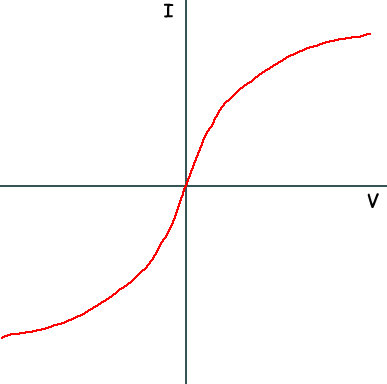Questions on Characteristic Curves - Filament Lamp
Q6.
(a) Sketch, on the axes below, the current–voltage (IV) characteristic for a filament lamp for currents up to its working power.

 The first mark was awarded for making it a straight line through the origin and then decreasing the gradient as V values get higher.
The first mark was awarded for making it a straight line through the origin and then decreasing the gradient as V values get higher. 
 The second mark was for symmetry.
The second mark was for symmetry. 
 You lost a mark if you drew a 'dip at end' of the characteristic or drew an 'extended horizontal section' at end of your line.
You lost a mark if you drew a 'dip at end' of the characteristic or drew an 'extended horizontal section' at end of your line.
 If you just drew a straight line, you scored zero!
If you just drew a straight line, you scored zero!
[2 marks]
(b)
(i) State what happens to the resistance of the filament lamp as the current increases.
The resistance of filament lamp increases as the current increases. 
[1 mark]
(ii) State and explain whether a filament lamp is an ohmic or non-ohmic conductor up to its working power.
The filament lamp is a non-ohmic conductor as current is not directly proportional to voltage. This means that its resistance is not constant. 
[1 mark]
(c) Three identical filament lamps, P, Q and R are connected in the circuit as shown below:

The filament in lamp Q melts so that it no longer conducts. Explain why lamp P becomes brighter and lamp R becomes dimmer.
When all lamps are lit the parallel arrangement for Q and P have less resistance than lamp R - lamp R therefore gets a bigger share of the voltage from the battery and will be brighter than Q and P (which will be of equal brightness).
When the filament in Q melts single bulbs are effectively in series and they get half of the voltage each. Therefore P is getting a bigger share of the voltage than it had before and it therefore is brighter , whereas R gets less voltage than before and therefore is dimmer
, whereas R gets less voltage than before and therefore is dimmer  (but now of equal brightness to lamp P).
(but now of equal brightness to lamp P).
[2 marks]
(d) A filament lamp, X, is rated at 60 W 230 V.
Another type of lamp, Y, described as 'energy saving' has the same light intensity output but is rated at 11 W 230 V.
(i) Calculate the electrical energy converted by each lamp if both are on for 4 hours a day for a period of 30 days.
 60W bulb
60W bulb
Energy = power x time
Energy = 60 x 602 x 4 x 30 = 2.6 x 107J 
 11 W bulb
11 W bulb
Energy = 11 x 602 x 4 x 30 = 4.8 x 106 J 
[2 marks]
(ii) Suggest why the two lamps can have different power ratings but have the same light intensity output.
In lamps energy is wasted in the form of thermal energy,  but the 'energy saving' lamp produces less thermal energy for the same amount of light energy produced,
but the 'energy saving' lamp produces less thermal energy for the same amount of light energy produced,  it therefore uses less electrical energy to produce the same luminocity and saves money in operating costs.
it therefore uses less electrical energy to produce the same luminocity and saves money in operating costs.
[2 marks]
(Total 10 marks)


